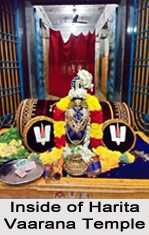 The architecture of the Hariata Vaarana Temple has attached a grandiose splendor to the traditional temple. The excellence of the architectural trappings is the clear evidence of the craftsmanship of the ancient artists. The main shrine of the Harita Vaarana Temple is east-facing. This famous Vishnu temple in Nazarethpettai enshrines the four-armed Pacchai Vaarana Perumal, the presiding deity of this temple, in a seated pose. He is surrounded by Goddesses Sri Devi and Bhu Devi by His side under the Dharmakoti Vimana. Apart from this the other vigrahas and their structure are highly captivating. The handsome utsava vigrahas of Perumal and His consorts (Ubhaya-nachiyar) are seated in front along with the images of Andal and Sudarsana. The pillared passage, which leads to this shrine houses the small images of several other deities, which enhance the beauty of the temple and at the same time, gives a flavor of the tradition and antiquity of the temple. The Stone and metal images of Garuda, Vishvaksena, Ramanuja and many of the Azhvars adorn the pillared passage of the entrance of the Temple. In front of this shrine there is erected a large mandapa which has a sanctum for Garuda facing the main shrine. It is in this pillared pavilion that the numerous mounts (vahanas) of the deity such as Garuda vahana, horse and elephant, which represents excellent posture of those vahanas.
The architecture of the Hariata Vaarana Temple has attached a grandiose splendor to the traditional temple. The excellence of the architectural trappings is the clear evidence of the craftsmanship of the ancient artists. The main shrine of the Harita Vaarana Temple is east-facing. This famous Vishnu temple in Nazarethpettai enshrines the four-armed Pacchai Vaarana Perumal, the presiding deity of this temple, in a seated pose. He is surrounded by Goddesses Sri Devi and Bhu Devi by His side under the Dharmakoti Vimana. Apart from this the other vigrahas and their structure are highly captivating. The handsome utsava vigrahas of Perumal and His consorts (Ubhaya-nachiyar) are seated in front along with the images of Andal and Sudarsana. The pillared passage, which leads to this shrine houses the small images of several other deities, which enhance the beauty of the temple and at the same time, gives a flavor of the tradition and antiquity of the temple. The Stone and metal images of Garuda, Vishvaksena, Ramanuja and many of the Azhvars adorn the pillared passage of the entrance of the Temple. In front of this shrine there is erected a large mandapa which has a sanctum for Garuda facing the main shrine. It is in this pillared pavilion that the numerous mounts (vahanas) of the deity such as Garuda vahana, horse and elephant, which represents excellent posture of those vahanas.
The specimen of the architectural evidence is also visible in the construction of the entire temple. A separate sanctum for Mudaliyandan situated near this mandapa which is of particular importance. This sanctum, which faces south, has the stone (moolavar) and metal (utsavar) images, with beautiful carvings of this famous preceptor seen here with the posture of folded palms (anjali hasta). There is also erected a tiny sanctum for Manavala Mamuni in front of the Mudaliyandan shrine facing east. The entire structure of the temple itself is the testimony of the excellent architectural piece of the contemporary era.
The deity of Goddess Lakshmi is worshipped in the temple as Amritavalli Thayar. It is situated to the right of the main shrine and the one dedicated to Andal is also seen in this enclosure (prakara). There is also erected a mandapa in front of the Thayar sanctum supported by very slender, beautiful pillars which reveal the exquisite craftsmanship of the master-artisans of the ancient Tamil country.
The architectural features of this clean and well-maintained single-prakara temple bespeak workmanship of Chola and Vijayanagara periods. The temple is attaining popularity day by day and it reflects an era of unsurpassed architectural grandeur in South India. This temple also has a five-tier gopura over the eastern entrance and to its right is erected the sanctum for Rama, which is seen with Devi Sita and Lakshmana beside Lord Rama and also small and captivating utsava vigrahas, surrounding these principal images. Immediately in front of the gopura on the outside is a mandapa standing on four pillars, is a true product of the Vijayanagara age. Situated diagonally opposite to the temple is the very large temple tank known as Dharma Pushkarini. However presently that sacred tank is sadly in an extremely dilapidated condition.





















